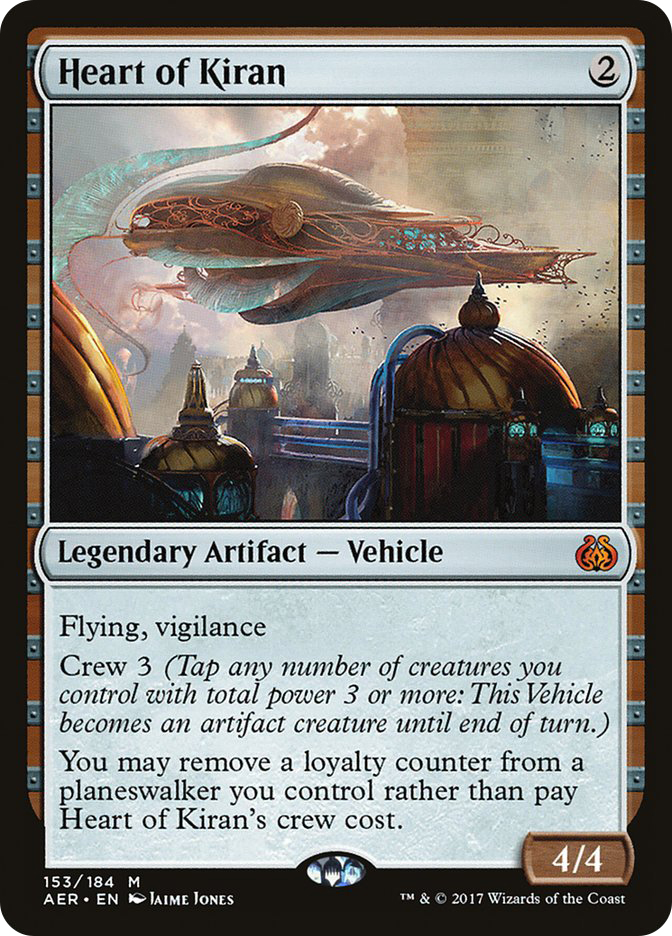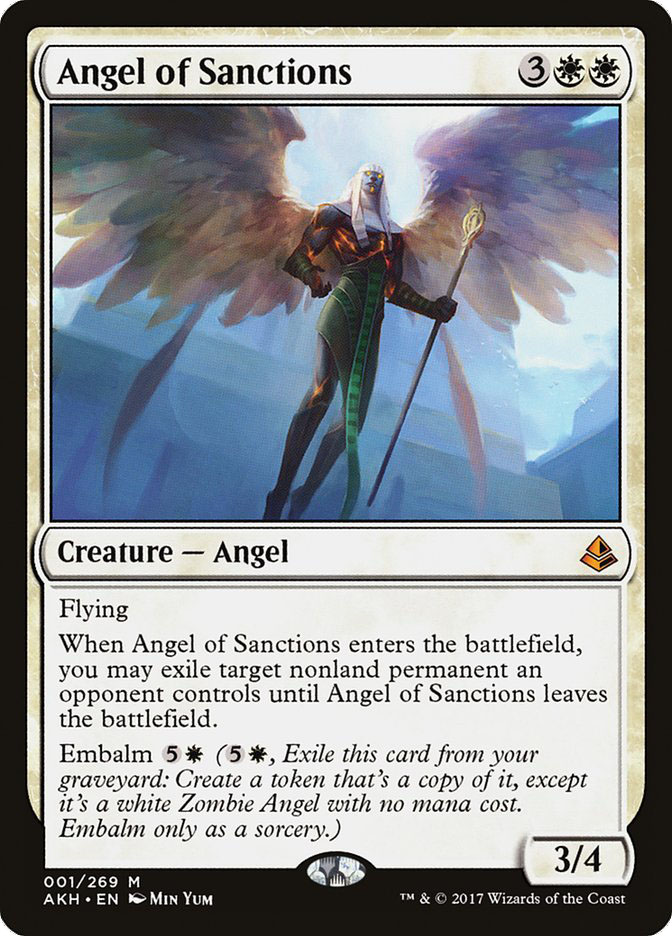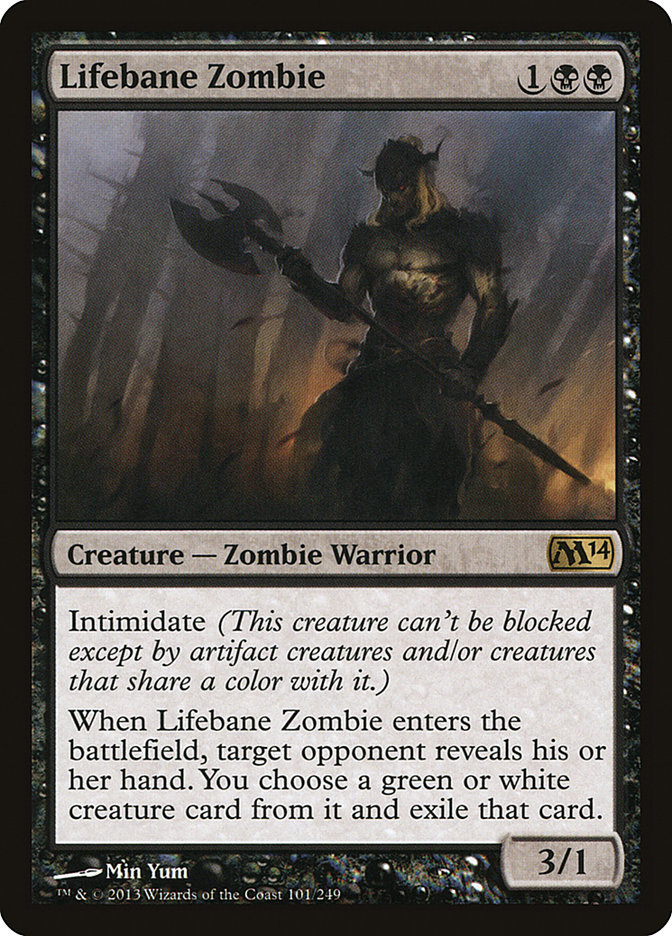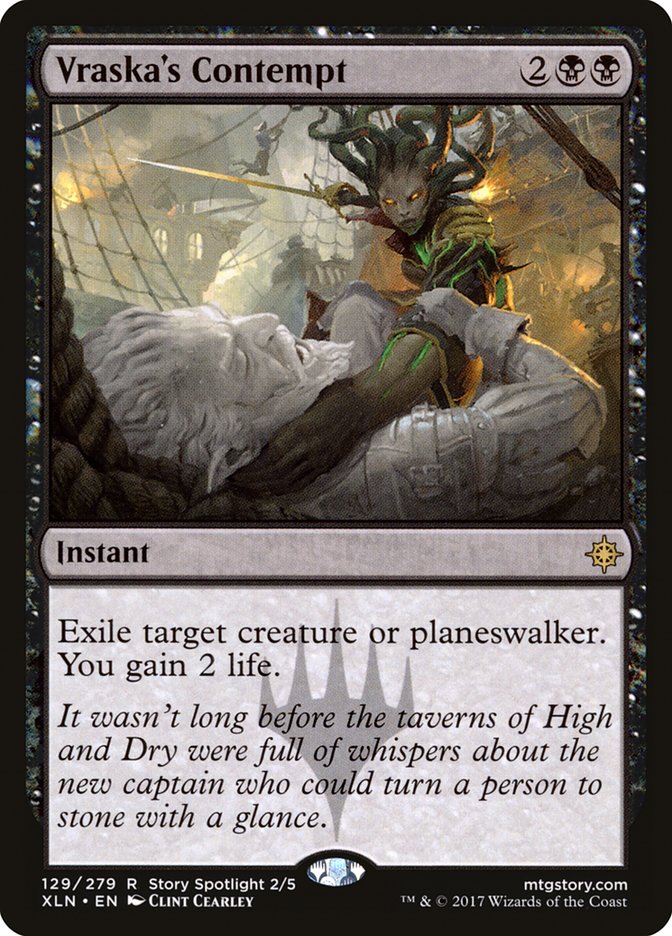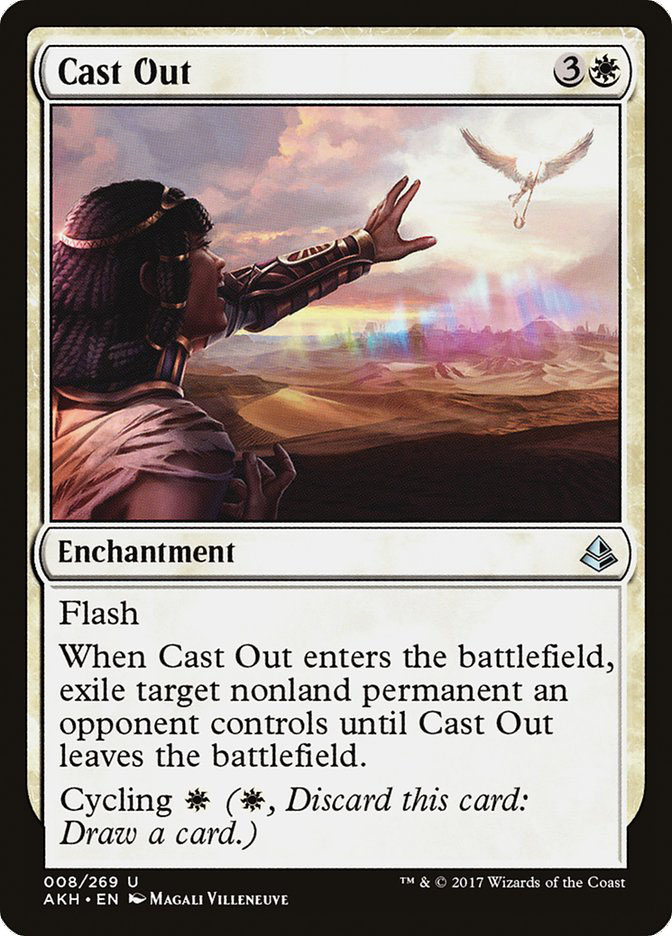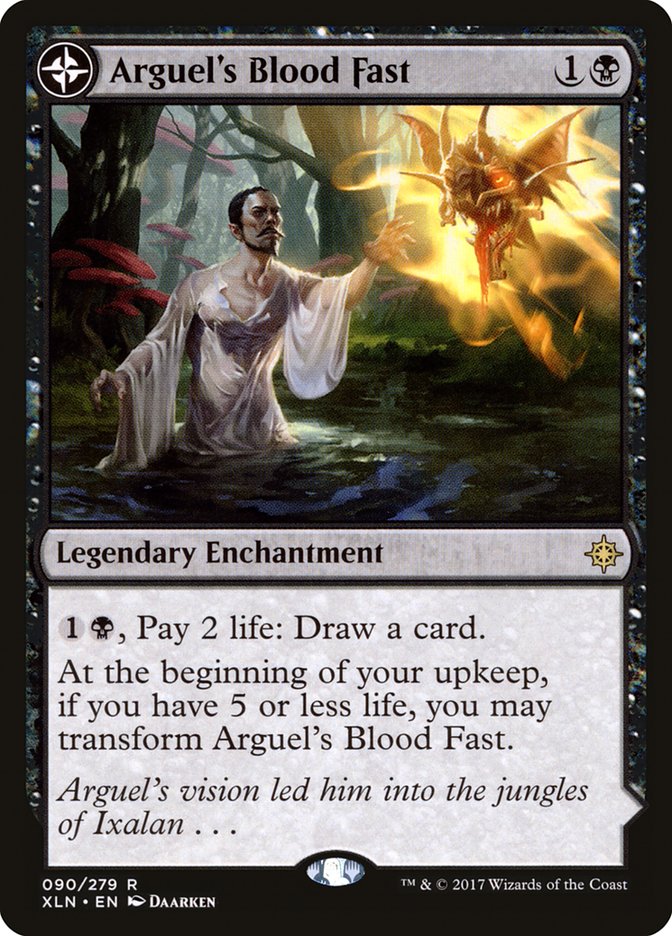They say the heart wants what it wants, but what does the heart actually want?
If the title and opening line wasn’t heavy-handed enough today we’re talking about Heart of Kiran, and two of the three decks this Vehicle has found itself in, R/B Aggro and W/B Aggro, both putting up big performances on their debut weekends and both functionally trying to do the exact same thing. Will there be a Highlander moment resulting in one of these decks becoming obsolete due to the other’s dominance, or is Standard big enough for both to exist? Those are the questions that are going to drive us today as we break down exactly what’s happening with everyone’s favorite dead dad.
Both decks were present on the first weekend of events featuring Dominaria but may have looked a little different. R/B Aggro was still playing cards like Inventor’s Apprentice and it seemed no one was aware of Goblin Chainwhirler’s potential just yet. In fact, many of the finest players on the SCG Tour took R/B Aggro to high finishes without introducing a single Dominaria card into their decklists. It’s like they weren’t even trying! Given this deck’s ordinary design it was ignored by the masses while U/W Control became the talk of the tournament as the deck had a new win condition in the shape of Teferi, Hero of Dominaria, a card I will forever regret not preordering.
Really, his name is “Hero of Dominaria” too? How original.
Anyway, there was another Standard tournament that took place that weekend but was hidden from the rest of the world. It happened on the internet in a place called “Magic Online.” There, hundreds of competitors fought in glorious Week 1 battle to see who could qualify for a Pro Tour that’s seven months away. MYYAMAGAT may have not taken home first place, but he eventually took home first place in our hearts.
Creatures (16)
Planeswalkers (3)
Lands (25)
Spells (16)

W/B Aggro eventually became the most talked about deck the following weekend in Baltimore for the following Team Constructed Open, but the only title this deck would take home was Zan Syed taking down the Classic with it. In second place was R/B Aggro, but this time it has a little spice. Michael Yue showed the world that this Boros Reckoner wannabe might not be the knock-off many of us would have expected it to be.
Creatures (23)
- 4 Bomat Courier
- 4 Scrapheap Scrounger
- 4 Inventor's Apprentice
- 4 Walking Ballista
- 3 Rekindling Phoenix
- 4 Goblin Chainwhirler
Planeswalkers (4)
Lands (24)
Spells (9)

R/B Aggro started to “take off” when between 200-400 people were consistently watching semi-pro, semi-famous, semi-good Matt Foulkes streamed the deck all week leading up to GP Birmingham to very middling results. Still, that was enough for the masses to work on the deck and show its true power. The world was just not ready for R/B Aggro, and the most unlikely of champions was crowned as Simon “Sleeping Through Life” Nielsen took down the entire thing with his new take of the deck.
Creatures (19)
- 2 Pia Nalaar
- 4 Scrapheap Scrounger
- 2 Walking Ballista
- 2 Glorybringer
- 3 Soul-Scar Mage
- 2 Rekindling Phoenix
- 4 Goblin Chainwhirler
Planeswalkers (4)
Lands (25)
Spells (12)

Again W/B Aggro wasn’t really to be seen in real life but continued to dominate on Magic Online as Daniel Fournier took down the weekend’s PTQ with the deck designed by none-other than Canada’s true Magic hero, Lucas Siow.
Creatures (16)
Planeswalkers (6)
Lands (24)
Spells (14)
Sideboard

Lucas’s take on the deck was like the others out there, but closer to what our own Gerry Thompson played at GP Birmingham. Gerry’s final list of the deck may not have been perfect, but it does seem to fit a trend we’re seeing from the more successful versions of the deck.
Creatures (16)
Planeswalkers (6)
Lands (24)
Spells (14)

So that brings us up to speed which means we can finally be done with this history lesson. Wait, did I forget to talk about Benalia? Oh well, we’ll just have to cover that another time. Now it’s time to get to the interesting stuff and break down exactly what we know about these decks. It’s important to ignore the similarities for now and focus on their differences instead. After all, they are both just Heart of Kiran / Scrapheap Scrounger shells with a four-mana planeswalker that transition into a midrange deck with ease. We’ve gotten some experience with decks like this over the years.
The biggest difference between the two decks is the difference in general power level. R/B Aggro doesn’t have the early starts that W/B does, but it makes up for it by having more interactive cards in the later turns. Goblin Chainwhirler can take down early drops while Chandra, Torch of Defiance and Glorybringer handle the mid-game creatures. This not only lets the deck play catch up against quicker starts but gives the deck higher impact topdecks when games devolve into topdeck wars. Given the deck doesn’t have the essential early game needed to combat more controlling strategies, R/B Aggro is inherently weak to things like U/W Control where W/B Aggro is not.
W/B Aggro does have cards like Toolcraft Exemplar and Knight of Malice to go alongside Heart of Kiran and Scrapheap Scrounger. This gives the deck a rather sizeable early game and can sometimes be enough to win a game when followed up by History of Benalia. Therein lies the biggest issue with W/B Aggro: the deck doesn’t play catch up as well as R/B Aggro. Looking at W/B Aggro’s decklist, it becomes apparent that the cards in it are much better on the play than they are on the draw.
Sometimes a later game Cast Out, Vraska’s Contempt, Karn, Scion of Urza, or Lyra Dawnbringer can stem the tide, but the deck really only has Fatal Push and Gideon of the Trials as cards that are great on the draw. That doesn’t mean the deck is always punished when on the draw though, as cards like History of Benalia are still good at making sure you have time to at least cast all your spells. It just means that the deck must lean on a transformational sideboard more than R/B Aggro. Those who knew this last weekend were successful with the deck and those who didn’t most likely got punished by the raw power of R/B Aggro.
That’s honestly what I believe happened. R/B Aggro is the more inherently powerful strategy, and thus exploited everyone’s unfamiliarity with how to properly adjust to the ever-changing metagame. Power does always excel in the early weeks of a format. Does that mean W/B Aggro will be better than R/B Aggro moving forward? I honestly couldn’t answer that specifically, but I do believe we will start to see more W/B Aggro, and slightly less R/B Aggro as people become more familiar with the strategies.
Daniel Fournier took down the Magic Online PTQ with a bold strategy against R/B Aggro: he completely transitioned into a midrange deck.
In:
Out:
It might not make the most sense, especially on the play, but controlling them does feel like the best way to attack the matchup. Even cards like Angel of Sanction overperform with this strategy when you’d think Chandra and Glorybringer would eat them up. Fournier’s strategy was to deploy them aggressively against tokens and Walking Ballistas to trade them off in combat only to embalm them when the game turned into a battle for resources.
This transition into a tapout control deck got deployed against R/B Aggro, Mono-Green Aggro, and G/B Constrictor. Only one other documented version of W/B Aggro looked like the Canadian’s and that was Gerry Thompson’s take that Ben Seck used to finish 28th at GP Birmingham after Gerry failed to make day two.
From this information I’m poised to believe that R/B Aggro’s dominance was not only a product of mass attention that the deck got leading up to the event, but also a misunderstanding of how W/B Aggro needed to be designed causing those pilots to suffer when paired against their red-based counterparts. That’s not to say R/B Aggro doesn’t deserve the attention it’s getting right now. It just means we shouldn’t ignore W/B Aggro assuming it’s a worse version.
Goblin Chainwhirler reminds me of Lifebane Zombie. When the black three drop first came out, people weren’t really prepared for its absurdness and paid the price. The first few weeks it was legal, Lifebane Zombie wrecked house but then became another part of the metagame. I believe this to be how Goblin Chainwhirler’s story will go. Its first week was glorious as people were just not prepared for it, but that will start to change. Less Teferi, Vindicator of Dominarias will get picked off due to negligence, less Glint-Sleeve Siphoners will see play, and thus make the card slightly worse. Still playable, of course, but not as good as it first was right out of the gates.
R/B Aggro is the deck I predict will have the shorter shelf-life out of these two, as it feels like the more exploitable strategy. U/W Control has already proven to punish the deck and we’re starting to see a resurgence of Mono-Red Aggro on Magic Online as less and less players continue to pilot W/B Aggro. So what makes R/B Aggro so exploitable? It’s based on power with very few flexible strategies to make up their sideboard.
Take another look at Simon’s list.
Creatures (19)
- 2 Pia Nalaar
- 4 Scrapheap Scrounger
- 2 Walking Ballista
- 2 Glorybringer
- 3 Soul-Scar Mage
- 2 Rekindling Phoenix
- 4 Goblin Chainwhirler
Planeswalkers (4)
Lands (25)
Spells (12)

First, the deck doesn’t get the ability to transition its gameplan after sideboard. Phyrexian Scriptures is the only true sweeper for the strategy, but all the decks where you’d want it not only have artifact creatures but also Thrashing Brontodons to go with them. There just isn’t a reliable way for the deck to do anything different. That said, I still think cards like Glorybringer, and Chandra are wonderful cards against strategies like this. I also believe both decks to be favored against G/B Constrictor as long as W/B Aggro has access to the control sideboard used by Fornier.
Temur Energy was also a deck designed around both Chandra and Glorybringer, but it had tools to at least compete with unique strategies that tried to exploit the strategy. No matter how much we want it to be, Duress will never be as good as Negate when facing off against control decks. One could say W/B Aggro doesn’t get unique tools either, but that’s not relevant given the deck’s inherently stronger against control because Knight of Malice is difficult to deal with, History of Benalia packs quite the punch over a long period of time, and even a turn one Toolcraft Exemplar puts control under serious pressure in the early game. Hand disruption acts differently in W/B Aggro than it does in R/B Aggro as one deck is better at presenting a serious clock. They can be strategically used to strip cards like Settle the Wreckage more often than simply used to increase the likelihood of a planeswalker sticking.
I do believe R/B Aggro to be favored against W/B Aggro but not by much, especially if R/B Aggro finds a good counter strategy to W/B Aggro’s control sideboard strategy. Learning how to appropriately build and execute sideboard plans is what makes this game so interesting, but the process to get it down can take weeks. I’m not confident in exactly how it should be done just yet but know that’s the key to winning the matchup. That said, it’s one of the last things that should be on R/B Aggro’s mind right now, as the deck does have a serious issue with both U/W Control and Mono-Red Aggro. Given that, my money is on W/B Aggro being the deck to beat this weekend.
Creatures (16)
Planeswalkers (6)
Lands (24)
Spells (14)
Sideboard

I agree with Gerry that the deck should have Forsaken Sanctuary, but I don’t think Plains is the cut. One of the biggest issues I’ve had with this deck is not having double white for turn three and this deck has many cards with that color requirement. I’m also not on board with Vraska’s Contempt over Cast Out, even though I’ve found I’m only cycling the card when I’m losing anyway. It’s just a stronger effect given that it can deal with any type of permanent at any time. Of course there are downsides to playing Cast Out like Thrashing Brontodon or other copies of Cast Out, but that’s a debate for another day.
I’m also not a big fan of Arguel’s Blood Fast in decks without counterspells. Card advantage is nice but it’s mostly wanted against decks like U/W Control, and they will most likely be okay with playing that game with you especially when you’re the one losing tempo by using it, and can’t make it back by countering their spells. It can, of course, be a powerful card, but this deck just isn’t the right home for it. That doesn’t mean I’m confident that Sorcerous Spyglass is better but I’ve liked the card in a variety of matchups, especially U/W Control where they really lean on Teferi, Hero of Dominaria and Azcanta, the Sunken Ruin to take over games. It also lets you know if they have Settle the Wreckage or not which can be a huge shift in a game’s dynamic.
So what do you think? Is W/B Aggro ready to make a comeback or are the inherent flaws in the strategy enough to keep it wanting live success but never achieving it? Will R/B Aggro find a way to combat these bad matchups or will it succumb to them. Will Mono-Red Aggro even show up in high enough numbers to really punish the deck? At this stage, it’s all really just speculation anyway so I’d love to hear your thoughts!


